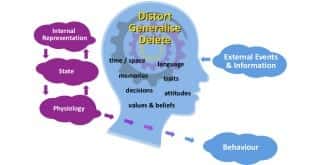The NLP Communication Model: What is your mind filtering out? What are you missing out on? What stories is your mind creating by the very nature by which it takes in and processes information?
Our minds take in and processes information and in turn this drives our behaviour – that makes logical sense, right? – information comes into our system/our neurology/our mind via our 5 senses – what we see, hear, feel/touch, taste and smell. However our minds, no matter how amazing, have some safety features – one of which is filtering information. Our mind is bombarded by around 2 million pieces of information per second – yep, I said 2 million!!! Our minds have to find a way of reducing this down to a level that it can process – it does this is a number of ways. One thing we do know is that the capacity of the unconscious mind to process information is far superior vs. the conscious mind – as a result of many studies, (most notably in the 50’s) it’s generally accepted that the mind can handle 7 bits of information (plus or mins 2).
The NLP Communication Model is one of the fundamental basics and foundations of NLP that we teach on all NLP Practitioner courses. It firstly shows us how our mind processes the information that comes into our system – how it deletes, distorts and generalises information – to make sense of it and get it down to a manageable size – if it did we’d be in system overload territory! Secondly it show us how our emotional state and physiology are intrinsically linked via our Internal Representations (see my earlier blog post here). It is these things combined that drive our behaviour (what we do & how we act) – today however we are going to focus on deletions, distortions and generalisations.
Our Mind is always deleting, generalising and distorting information …
What is actually happening:
- Deletions – some information we are faced with is disregarded (e.g. it’s ‘thrown in the bin’) – wherever you are right now information is entering your system and being deleted because it’s not relevant – for example, I am sat on a chair in a hotel waiting for a client – my mind doesn’t naturally process the feeling of the chair I’m sat on, the child that runs past, the noise of the chatting in the background, the fact someone just turned off the light – it’s not relevant to what I am doing, so it disregards it (unless of course I expand my awareness to notice these things, as I just did in order to be able to tell you about them!)
- Distortions -This is where information is twisted or tweaked in order for it to fit (a bit like a child playing with soft bricks and the only bricks that go through the hole are those that can be manipulated to be the right angle, shape etc to go into the cube). We distort whatever is going on in the world to fit how we see the world – so we only take in that which is important to us.
- Generalisations – this is where information comes in via our senses and our mind recognises that it’s similar to what’s gone before – it’s had similar information come into the neurology before and in order to process the information in a tiny fraction of a second it has to process it, it decides the fastest way to deal with it is to generalise that what happened last time this type of info came in (e.g. x,y,z happened) and so the mind generalises that the same will happened again. For example, I smell the freshly baked bread and so I generalise that it will taste amazing – because that’s what’s happened before (numerous times for me!)
It also filters the information (through things like our values, beliefs, memories etc – which is the topic of another post) and out of that pops what we refer to as an Internal Representation (commonly referred to in NLP circles as an ‘IR’). As the most simplistic level, it is this (along with a couple of other bits) that drives our behaviour – what we do.
What can we learn our mind from the NLP Communication Model?
In a business context we need to understand that our audience can only take in 7 bits of information (plus or minus 2) at any one time – instead of putting everything in PowerPoint slides, be picky about what you display – want do people need to remember? – my tip is only to put on slides the critical things. As the saying goes, ‘sometimes less is more’ – to the point that sometimes I don’t use slides at all.
Acknowledge that people are ‘deleting’ all the time – have you ever been in a meeting and come out and someone says ‘did you hear what s/he said about x,y,z’ – and you think, nope! – it’s the processes that your mind is running – it clearly didn’t think it was important enough, so it’s likely to have deleted that information. On the flip-side just because someone agrees with you, it doesn’t mean you’re right – you could both have deleted, distorted or generalised in similar ways. This is exactly why witness statements are so unreliable! Try not to get frustrated with yourself or others when this happens – acknowledge what is going on and think about what you can learn from this, the learnings will allow you to take something valuable from the experience.
In day to day life, we can learn that our reality, is in fact the output of the whole process of deleting, distorting and generalising (as well as the other processes and other unconscious mind stuff – all of which we cover on our live NLP training courses) – what we believe to be the facts or true about something or a situation may indeed not be true at all. What you believe and what I believe about something may well be different – this too is the byproduct of these types of processes in our mind. It’s helpful to understand how our mind is working when considering some of the unhelpful commentary/stories that we sometimes run through our head (we refer to it as ‘self-talk’) – unhelpful self-talk can be accepted as just that, unhelpful.
Have you ever come across a situation where you like someone, but your friend say ‘I can’t stand them, they are so rude!’ This is simply that you can see something that they can’t or vice versa. Perhaps the behaviour your friend is seeing reminds them of someone, and so now you can recognise they are simply generalising. What is one person’s ‘bossy’ is another person’s ‘leadership’ etc.
How do I find out more about how my mind works and the NLP Communication Model?
We recommend booking onto the NLP Practitioner course if you really want to start to understand how your mind works. The NLP Practitioner course is the first certified NLP course that we run and it will give you all the tools you need to help others and get great personal development for you! If you’ve already completed your NLP Practitioner course, then your ready to take your NLP knowledge to the next level with the Master Practitioner course. Details of all our NLP Training can be found here.
Want to speak to us – feel free to call us on 02920 023311 or email [email protected]



